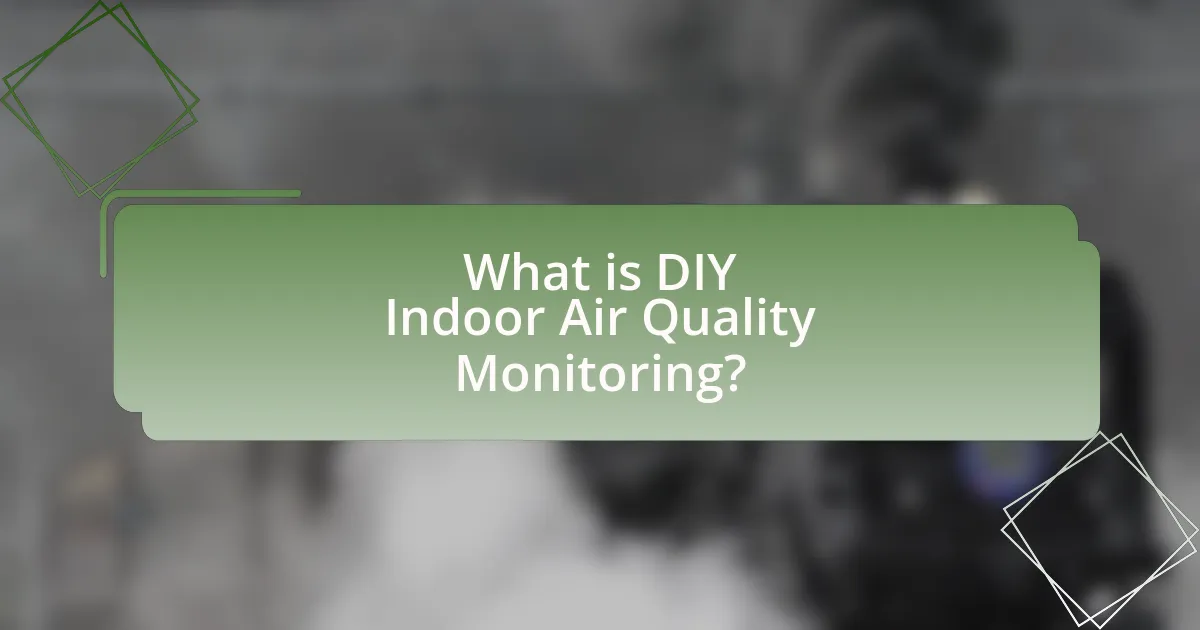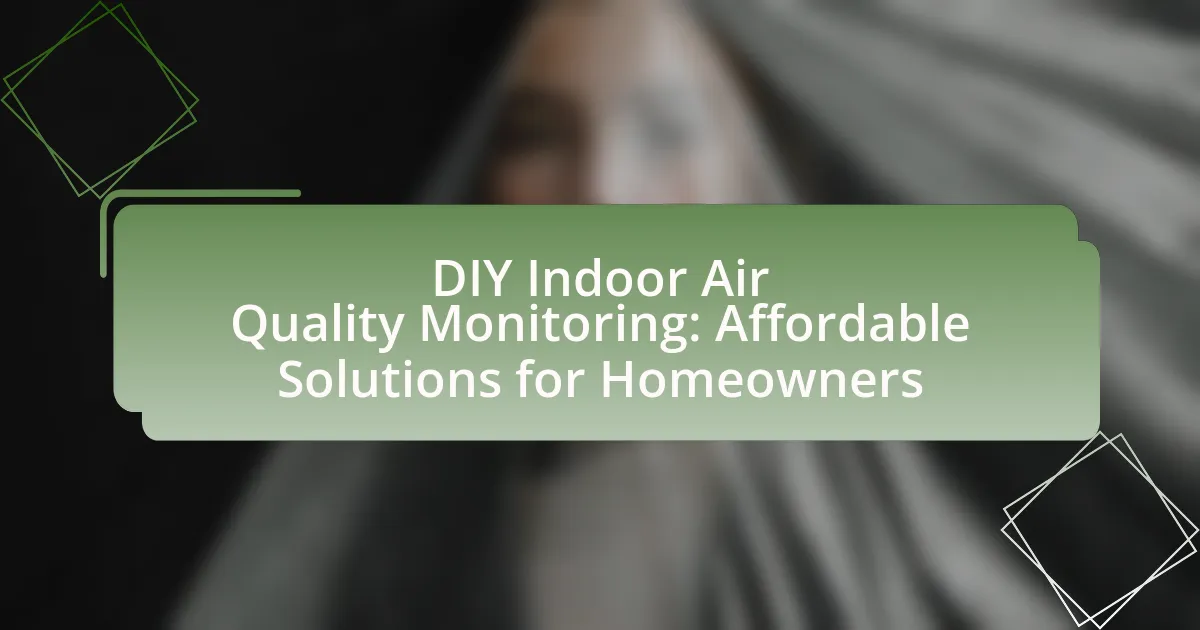DIY Indoor Air Quality Monitoring involves individuals assessing and managing the air quality in their homes using accessible tools and methods. This article outlines how homeowners can utilize affordable sensors and devices to measure pollutants such as volatile organic compounds (VOCs), particulate matter, humidity, and carbon dioxide levels. It discusses the essential components of a DIY air quality monitoring system, the importance of maintaining good indoor air quality for health and comfort, and the various affordable solutions available for effective monitoring. Additionally, it addresses common challenges, troubleshooting techniques, and best practices for ensuring accurate and reliable air quality assessments.
What is DIY Indoor Air Quality Monitoring?

DIY Indoor Air Quality Monitoring refers to the practice of individuals assessing and managing the air quality within their homes using accessible tools and methods. This approach allows homeowners to measure pollutants such as volatile organic compounds (VOCs), particulate matter, humidity, and carbon dioxide levels, often through the use of affordable sensors and monitoring devices. By actively monitoring these factors, homeowners can identify potential health risks and take corrective actions to improve their indoor environment, thereby enhancing overall well-being.
How does DIY Indoor Air Quality Monitoring work?
DIY indoor air quality monitoring works by utilizing sensors and devices that measure various pollutants and environmental conditions within a home. These devices typically track parameters such as particulate matter, volatile organic compounds (VOCs), carbon dioxide levels, humidity, and temperature.
The collected data is often transmitted to a smartphone app or a computer interface, allowing homeowners to monitor air quality in real-time. Many DIY systems also provide alerts when pollutant levels exceed safe thresholds, enabling timely actions to improve indoor air quality.
Research indicates that poor indoor air quality can lead to health issues, making monitoring essential for maintaining a healthy living environment. For instance, the Environmental Protection Agency (EPA) highlights that indoor air can be two to five times more polluted than outdoor air, underscoring the importance of effective monitoring solutions.
What are the essential components of a DIY air quality monitoring system?
The essential components of a DIY air quality monitoring system include sensors, a microcontroller, a power source, and a data display or logging system. Sensors detect specific air quality parameters such as particulate matter, volatile organic compounds, carbon dioxide, and humidity. A microcontroller, such as an Arduino or Raspberry Pi, processes the data from the sensors. A reliable power source, like batteries or a USB connection, ensures the system operates continuously. Finally, a data display or logging system, which can be an LCD screen or a cloud-based application, allows users to visualize and analyze the air quality data collected. These components work together to provide accurate and real-time monitoring of indoor air quality.
How do sensors measure indoor air quality?
Sensors measure indoor air quality by detecting and quantifying various pollutants and environmental parameters such as particulate matter, volatile organic compounds (VOCs), carbon dioxide, and humidity levels. These sensors utilize technologies like electrochemical sensors for gas detection, laser scattering for particulate matter, and capacitive or resistive methods for humidity measurement. For example, electrochemical sensors can provide real-time data on harmful gases, while laser scattering sensors can accurately measure the concentration of airborne particles. This data is crucial for assessing air quality and ensuring a healthy indoor environment.
Why is indoor air quality important for homeowners?
Indoor air quality is important for homeowners because it directly affects health, comfort, and overall well-being. Poor indoor air quality can lead to respiratory issues, allergies, and other health problems, with studies indicating that indoor air can be two to five times more polluted than outdoor air. Maintaining good air quality helps reduce the risk of these health issues, enhances comfort levels, and can even improve productivity within the home environment.
What health risks are associated with poor indoor air quality?
Poor indoor air quality is associated with several health risks, including respiratory issues, cardiovascular diseases, and exacerbation of allergies and asthma. Exposure to pollutants such as volatile organic compounds (VOCs), particulate matter, and mold can lead to symptoms like coughing, wheezing, and shortness of breath. According to the World Health Organization, indoor air pollution is responsible for approximately 4.3 million premature deaths annually, primarily due to respiratory infections and chronic obstructive pulmonary disease (COPD). Additionally, long-term exposure to poor air quality can increase the risk of heart disease and stroke, highlighting the critical importance of maintaining healthy indoor environments.
How can improved air quality enhance home comfort?
Improved air quality enhances home comfort by reducing allergens, pollutants, and odors, leading to a healthier living environment. When indoor air quality is elevated, occupants experience fewer respiratory issues, such as asthma and allergies, which are often triggered by airborne contaminants. Studies indicate that better air quality can increase overall well-being and productivity, as clean air promotes clearer thinking and reduces fatigue. For instance, the Environmental Protection Agency (EPA) highlights that indoor air can be two to five times more polluted than outdoor air, emphasizing the importance of monitoring and improving air quality for enhanced comfort and health.
What affordable solutions are available for DIY air quality monitoring?
Affordable solutions for DIY air quality monitoring include low-cost sensors such as the MQ series gas sensors, which can detect various pollutants like carbon monoxide and methane. These sensors are widely available for under $20 and can be integrated with microcontrollers like Arduino or Raspberry Pi for real-time monitoring. Additionally, software platforms like OpenAQ provide access to air quality data, allowing users to compare their readings with local air quality indices. Using these tools, homeowners can effectively monitor indoor air quality without significant financial investment.
What types of DIY air quality monitors can homeowners build?
Homeowners can build several types of DIY air quality monitors, including particulate matter sensors, gas sensors for detecting volatile organic compounds (VOCs), and carbon dioxide monitors. Particulate matter sensors, such as those using the PMS5003 sensor, measure airborne particles and provide data on air quality levels. Gas sensors, like the MQ series, can detect various gases, including carbon monoxide and methane, allowing homeowners to monitor harmful emissions. Carbon dioxide monitors can be constructed using sensors like the MH-Z19, which helps assess indoor air quality related to ventilation. These DIY solutions are cost-effective and can be tailored to specific air quality concerns.
How can homeowners repurpose existing technology for air quality monitoring?
Homeowners can repurpose existing technology for air quality monitoring by utilizing devices such as smartphones, smart home assistants, and weather stations. Smartphones can run air quality monitoring apps that utilize built-in sensors to detect pollutants and provide real-time data. Smart home assistants, like Amazon Echo or Google Home, can be integrated with air quality sensors to monitor indoor air quality and provide alerts. Additionally, weather stations can be adapted to measure indoor air quality by incorporating particulate matter sensors, allowing homeowners to track air quality trends over time. These methods leverage readily available technology to create an effective air quality monitoring system without significant investment.
How can homeowners effectively implement DIY air quality monitoring?
Homeowners can effectively implement DIY air quality monitoring by utilizing affordable sensors and mobile applications designed for tracking indoor air quality. These sensors can measure pollutants such as particulate matter, volatile organic compounds, and carbon dioxide levels, providing real-time data on air quality. For instance, devices like the Eve Room or the Airthings Wave Plus are user-friendly and can connect to smartphones for easy monitoring. Studies indicate that indoor air quality can be significantly improved by regularly checking and addressing sources of pollution, such as mold or inadequate ventilation, thus validating the importance of consistent monitoring.
What steps should be taken to set up a DIY air quality monitoring system?
To set up a DIY air quality monitoring system, first gather essential components such as air quality sensors, a microcontroller (like Arduino or Raspberry Pi), and a power source. Next, connect the sensors to the microcontroller according to the manufacturer’s instructions, ensuring proper wiring and configuration. After that, program the microcontroller to read data from the sensors and display it on a connected screen or send it to a cloud service for remote monitoring. Finally, calibrate the sensors as needed to ensure accurate readings and place the system in the desired location for monitoring. This approach allows homeowners to track indoor air quality effectively and affordably.
How can data from DIY monitors be interpreted for actionable insights?
Data from DIY monitors can be interpreted for actionable insights by analyzing the collected measurements of indoor air quality parameters such as temperature, humidity, particulate matter, and volatile organic compounds. Homeowners can use this data to identify patterns and trends that indicate poor air quality, enabling them to take specific actions like improving ventilation, using air purifiers, or adjusting humidity levels. For instance, a study published in the Journal of Environmental Monitoring found that monitoring particulate matter levels can help residents understand when to reduce outdoor activities or increase indoor air filtration, thus directly linking data interpretation to health outcomes.
What are the common challenges in DIY indoor air quality monitoring?
Common challenges in DIY indoor air quality monitoring include the accuracy of sensors, the complexity of data interpretation, and the variability of indoor air pollutants. Many DIY sensors may not provide reliable measurements, leading to potential misinterpretations of air quality levels. Additionally, users often struggle to understand the data collected, as it requires knowledge of various pollutants and their health impacts. Furthermore, indoor air quality can fluctuate significantly due to factors like occupancy, ventilation, and external environmental conditions, complicating consistent monitoring efforts.
How can homeowners troubleshoot issues with their DIY air quality systems?
Homeowners can troubleshoot issues with their DIY air quality systems by systematically checking each component for functionality and ensuring proper calibration. First, they should verify that all sensors are clean and free from obstructions, as dirt can affect readings. Next, homeowners should confirm that the power supply is stable and that connections are secure, as loose wires can lead to intermittent failures. Additionally, recalibrating sensors according to the manufacturer’s instructions can help restore accuracy. If problems persist, consulting online forums or user manuals specific to the air quality system can provide targeted solutions, as many common issues have documented fixes.
What maintenance practices are essential for effective monitoring?
Essential maintenance practices for effective monitoring include regular calibration of monitoring devices, routine cleaning of sensors, and periodic software updates. Calibration ensures that devices provide accurate readings, as environmental factors can affect sensor performance over time. Cleaning sensors prevents dust and debris from interfering with measurements, which is crucial for maintaining data integrity. Additionally, software updates often include improvements and bug fixes that enhance functionality and accuracy, ensuring that the monitoring system operates optimally. Regularly implementing these practices helps maintain reliable indoor air quality monitoring.
What best practices should homeowners follow for effective air quality monitoring?
Homeowners should regularly use air quality monitors to effectively track indoor air pollutants. These devices measure levels of common contaminants such as particulate matter, volatile organic compounds (VOCs), and carbon dioxide, providing real-time data on air quality. Additionally, homeowners should place monitors in various rooms to capture a comprehensive view of air quality throughout the home, as pollutant levels can vary by location. Regular calibration and maintenance of these devices ensure accurate readings, while keeping windows open for ventilation can help reduce indoor pollutant concentrations. Studies indicate that indoor air can be two to five times more polluted than outdoor air, emphasizing the importance of consistent monitoring and proactive measures to maintain a healthy living environment.

Leave a Reply